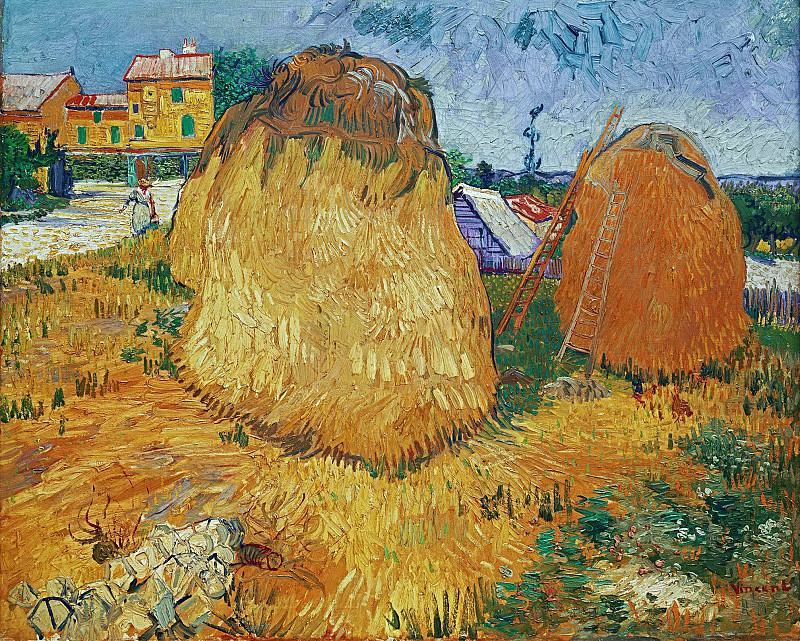Haystacks in Provence Vincent van Gogh (1853-1890)
Vincent van Gogh – Haystacks in Provence
Edit attribution
Download full size: 2013×1611 px (0,9 Mb)
Painter: Vincent van Gogh
Location: Kröller-Müller Museum, Otterlo.
1888; canvas, oil; 73.0×92.5; Kröller-Müller Museum. The period of his life in Arles is characterized in Van Gogh’s work by an abundance of landscape painting. In his paintings he tried to capture the beauty of the surrounding nature, which needed no artificial grooming. The painting Haystacks in Provence is simple in composition and charms the eye with its unpretentiousness. Rich yellow color fills the picture with warm summer glow.
A description of Vincent van Gogh’s painting Haystacks in Provence
1888; canvas, oil; 73.0×92.5; Kröller-Müller Museum.
The period of his life in Arles is characterized in Van Gogh’s work by an abundance of landscape painting. In his paintings he tried to capture the beauty of the surrounding nature, which needed no artificial grooming.
The painting Haystacks in Provence is simple in composition and charms the eye with its unpretentiousness. Rich yellow color fills the picture with warm summer glow. Two big stacks of harvested straw, which occupy the central place on the canvas, are painted in yellow. They seem to dominate everything else, their lush yellowness here and there diluted by shoots of green grass stowed in the stack at random.
Yellow is the color of the field, where the stacks are stacked, the road in the background, leading to the village. The large two-story house is yellow, as are the reflections on the roofs of the huts further away near the horizon. The contrast is created by the blue summer sky above, with reflections of purple visible in the wooden structures on the ground.
Small details further enliven the landscape: a woman with a bucket and a straw hat wandering along the road, ladders left by the workers at the second stack, clothes thrown over the straw. These traces of human presence are a reminder that the pastoral picture of rural nature is not created just to admire it. Behind all this is the work of people for whom all the splendor around them is not a work of art, but an everyday occurrence.
Кому понравилось
Пожалуйста, подождите
На эту операцию может потребоваться несколько секунд.
Информация появится в новом окне,
если открытие новых окон не запрещено в настройках вашего браузера.
You need to login
Для работы с коллекциями – пожалуйста, войдите в аккаунт (open in new window).




















COMMENTS: 1 Ответы
ФИЛОСОФИЯ НА ФОНЕ СТОГА
Был стог – как терем золотой!
Палаты сказочные! Диво!
Был кем-то сложен терпеливо,
И пропитал его покой.
И он былым благоухал,
Как будто будущего нету.
И он сиял и утешал
Давно грустящую планету.
И золотистое тепло
Текло в мою больную душу.
И показалось даже – зло
Когда-нибудь покинет сушу.
И было время золотым,
Как мёд, отобранный у пчёлок.
И я подумал – быть седым
Не страшно в мире невесёлом.
И я смотрел и постигал
Земного бытия струенье.
Как бы к истокам припадал
Вселенского миротворенья.
You cannot comment Why?
To the left, a small village with yellow buildings and red roofs is visible, with a solitary figure walking on a path, adding a touch of human presence to the landscape. In the background, a few trees provide a splash of green against the sky. The sky itself is a dynamic mix of blues and grays, with swirling patterns that suggest movement and atmosphere. Two wooden ladders lean against the right haystack, implying ongoing agricultural work.
The subtext of the painting can be interpreted in several ways. The haystacks, symbols of abundance and the fruits of labor, are presented with an almost monumental presence, highlighting the dignity and importance of rural life. The impasto technique and vibrant colors lend a sense of energy and emotion to the scene, reflecting Van Goghs intense connection to nature and his subjective experience of it. The small human figure in the distance might symbolize humanitys humble place within the grandeur of the natural world. The overall impression is one of a thriving, sun-drenched landscape alive with the quiet rhythm of country existence, even amidst the artists personal turmoil.